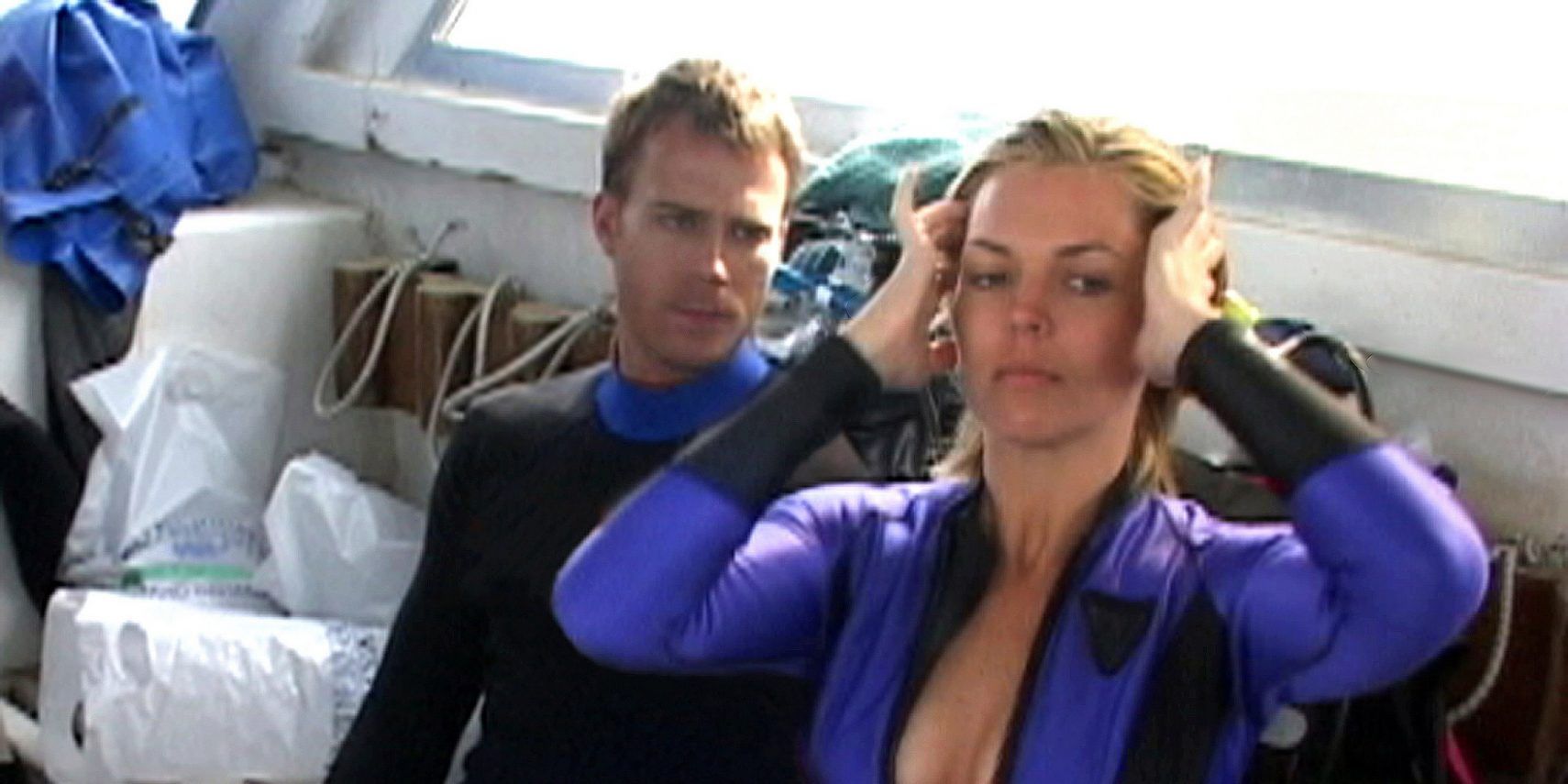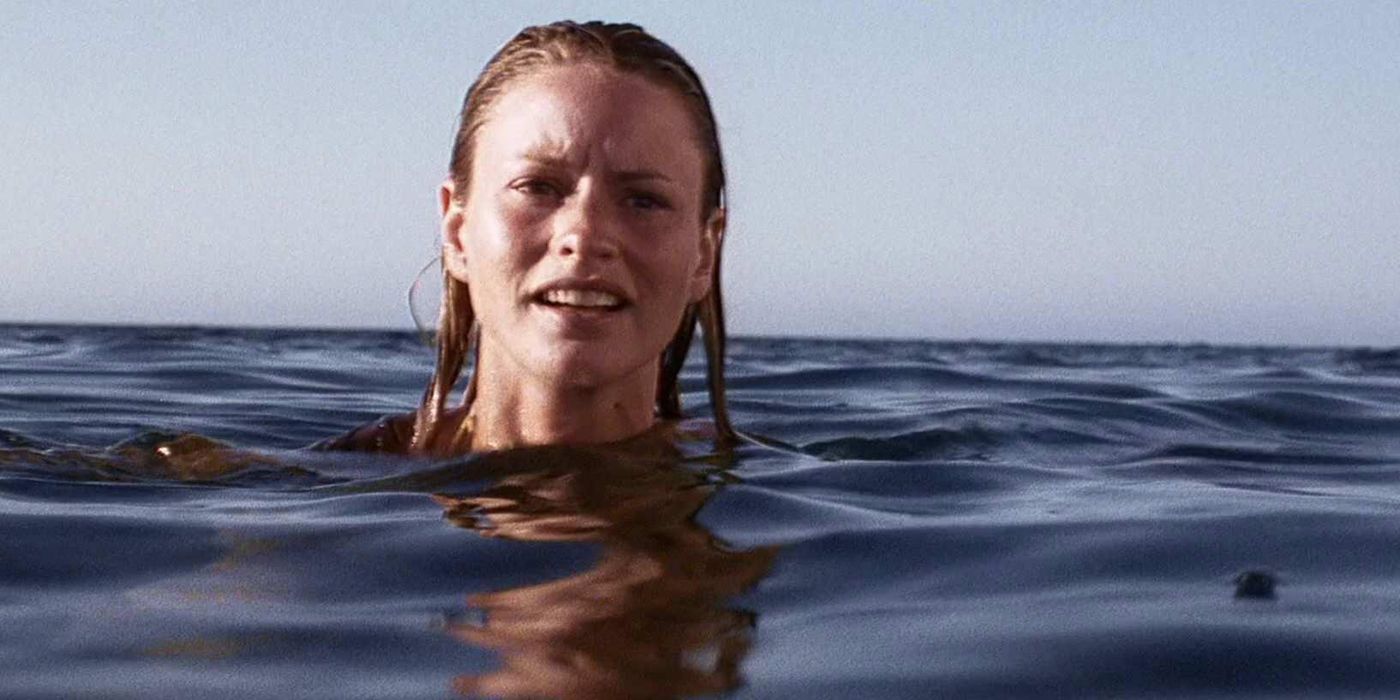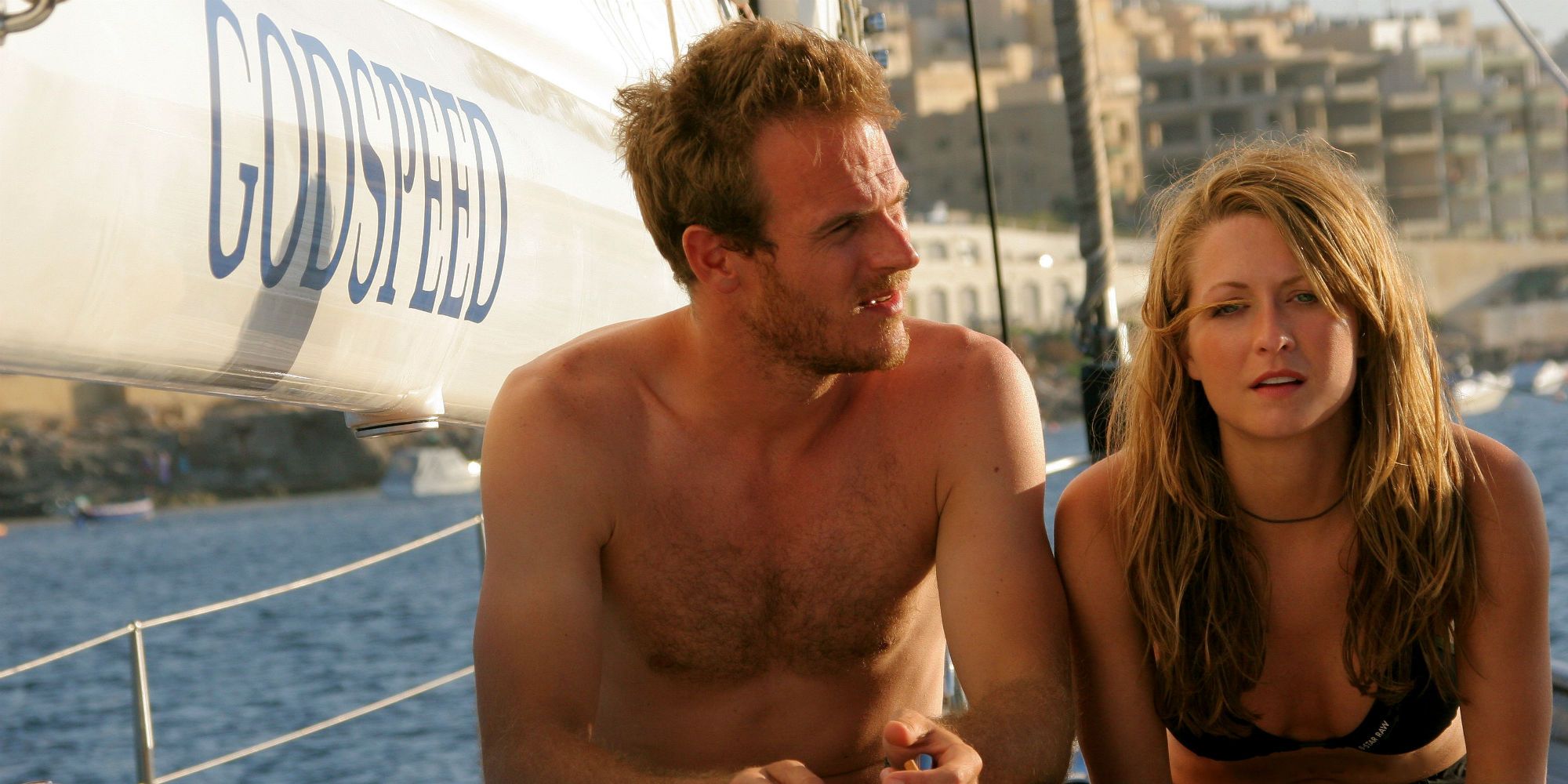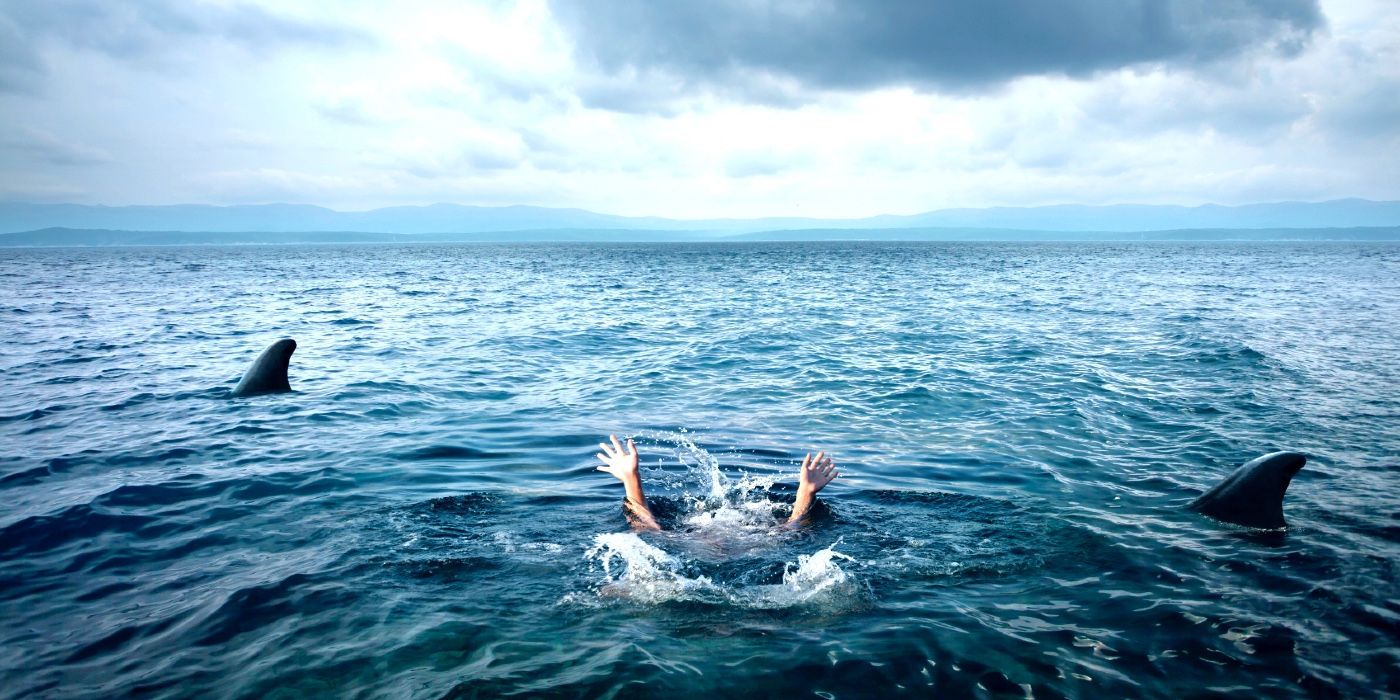2003's Open Water shark movie is based on actual events surrounding the disappearance of an American couple scuba diving in the shark-infested waters around the Great Barrier Reef off the coast of Queensland, Australia. The movie was written and directed by Chris Kentis, and produced by Kentis' wife Laura Lau — both avid divers. The couple shot the film over the span of two years, and they funded the project with $130,00 of their own money. The movie became a sleeper hit, upended the Killer Shark genre, and went on to earn over $54 million worldwide.
The Open Water shark movie tells the terrifying story of a couple, Daniel Kintner (Daniel Travis) and Susan Watkins (Blanchard Ryan), who go on a diving expedition and find themselves stranded 20 miles offshore. What makes Open Water a different type of killer shark movie than say, The Meg or Deep Blue Sea, is that it's based on a harrowing true tale — albeit with a few necessary tweaks to make it work for the big screen. So successful was the formula that an initially unrelated movie was retooled during production to become the Open Water sequel, Open Water 2: Adrift. Here's the original Open Water movie true story explained.
Tom and Eileen Lonergan: The Open Water Movie True Story
Open Water focuses on fictional holidaymakers Daniel and Susan, but their story is based on a real-life tragedy that befell Tom and Eileen Lonergan. During a vacation at an undisclosed location in the Open Water shark movie, Susan and Daniel embark on a scuba diving trip and stray from the group. They resurface to discover the tour boat has left them behind after a member of the crew performs an inaccurate headcount. At first, the couple believes their absence will be noticed, but as the hours wear on, their situation's harsh reality begins to sink in. Unfortunately, this nightmare scenario is on possibility for what happened to Tom and Eileen Lonergan.
Of course, Open Water does embellish some details since exactly what happened to the Lonergans still isn't known. The Open Water movie's most frightening moments are derived from the presence of multiple numbers of sharks that Susan and Daniel are powerless to fend off. Eventually, Daniel is bitten, and at some point during the night, he dies either of blood loss or shock. Susan releases Daniel and watches his body get ravaged by the predators. Realizing she's going to die, Susan removes her gear and sinks beneath the surface. However, while it's possible Tom and Eileen Lonergan met their end at the hands of multiple sharks, the true Open Water story is actually part of a mystery.
Tom and Eileen Lonergan disappeared in January 1998 during an expedition run by Outer Edge Dive to the rim of the Great Barrier Reef 40 miles offshore Port Douglas, Queensland. As in the movie, Tom and Eileen went off on their own and resurfaced late. It took two days for the boat's skipper to report the couple's disappearance — in the film, the incident is reported the next morning — leading to a week-long search, but their bodies were never found. In the weeks following the couple's disappearance, pieces of their scuba equipment washed up on a deserted beach, and while there was damage, it was attributed to coral and not an animal attack.
According to a 2004 article in the New York Times, some people believed the Lonergan's faked their deaths, a conspiracy theory authorities debunked. Journals found among the Lonergan's personal belongings painted Tom as a man with a "death wish." This led to speculation that Tom may have killed Eileen and then himself. Eileen's father, John Hains, believes Tom and Eileen became dehydrated and disoriented, which would have led them to shed their suits and equipment, resulting in death by drowning or sharks. While there's no way of knowing with certainty what happened to Tom and Eileen Lonergan, the mystery was more than enough to be the real events that inspired Open Water.
Why The Open Water Director Turned The Lonergan's Story Into A Movie
Kentis learned about the incident from a dive newsletter. In a 2004 interview with IndieWire, Kentis said: "I did a lot of research on various men who are left at sea at wartime, like the USS Indianapolis. And we also used our own experiences as divers. What was pertinent to us was how it happened, so the characters are fictitious because they weren’t pertinent to the story that we were telling." Kentis told the New York Times that he used the idea of a couple abandoned at sea, but steered clear of the sensationalized accounts surrounding the Lonergan's case, feeling they would undermine the film's credibility.
Instead, Kentis and Lau used digital video, two actors, and a herd of real sharks to create a horror movie with a documentary aesthetic. Open Water resonates with audiences because it's a fresh take on previous shark movies. "Pretty much any film with a shark is kind of the same thing, somebody falls in the water, and the shark rips them apart. We wanted to take a more realistic approach." The Lonergan's real-life story makes for compelling true crime fodder for the scary CGI-free Open Water, but the circumstances that led to the Lonergans being left behind are the only similarities between the incident and Kentis' story of a doomed couple lost at sea.
The Open Water Sequel Is Based On A Novel
Unlike the Open Water shark movie that's inspired by real events, the 2006 sequel Open Water 2: Adrift is an adaptation of a short story — a story that isn't at all connected to the disappearance of Tom and Eileen Lonergan. Since the second Open Water movie was marketed with the tagline "BASED ON TRUE EVENTS", many viewers believed it was also derived from a real-life case of a shark attack like the first Open Water. The short story that inspired Open Water 2: Adrift is entirely fictional though.
The "true events" behind the second Open Water was written by Japanese author Koji Suzuki, the author of the novel adapted into 1991's The Ring (Ringu). The short story, Adrift, was part of the 1996 collection Dark Water, which also contained the short story eventually adapted into the 2005 movie of the same name. Interestingly, Open Water 2: Adrift was originally intended to be a straightforward adaptation of the Koji Suzkui story entirely unrelated to the first Open Water movie. It was thanks to Open Water's success that the follow-up became attached as part of the same franchise, as this was the only way studios would option the story.
Shark Movies Like Open Water Create Dangerous Stereotypes
While the Open Water shark movie dips its toes in the ocean of realism, there are still stereotypes that are perpetuated about the endangered species which could cause major harm to their environment. Shark attacks are rare occurrences, and usually the result of the animal being confused or curious. For example, if a shark sees a human splashing around in the water, it may go to investigate which would lead to an accidental attack. The three biggest culprits of shark attacks are usually great whites, tiger sharks, and bull sharks. Like with most animals, sharks are far more afraid of humans than we are of them, and populations have been on the decline due to hunting practices like finning.
Shark movies like Open Water, Jaws, Deep Blue Sea, or The Meg portray the creature in a particularly dangerous light, with the cultural ripple of timeless classics like Jaws leaving a lasting impact on beach goers and movie watchers alike. In fact, Jaws had such an influence on the public that Christopher Neff of the University of Sydney proposed there's a phenomenon called "the Jaws effect," which resulted in three unfounded beliefs: the belief that sharks intentionally bite humans, that shark encounters are always fatal, and that they should be killed to prevent future attacks.
Since Jaws, shark populations have fallen at an alarming rate, decreasing by nearly 71%. The chances of encountering a shark are extremely slim, but movies like Open Water, Jaws, and Deep Blue Sea introduce inaccuracies about the species, possibly causing harm to the endangered animals. Neff's point was that policymakers and politicians aren't immune from unfounded stereotypes, so increasingly aggressive shark population control measures have been introduced following the release of hit shark movies, even accurate true stories like Open Water.





